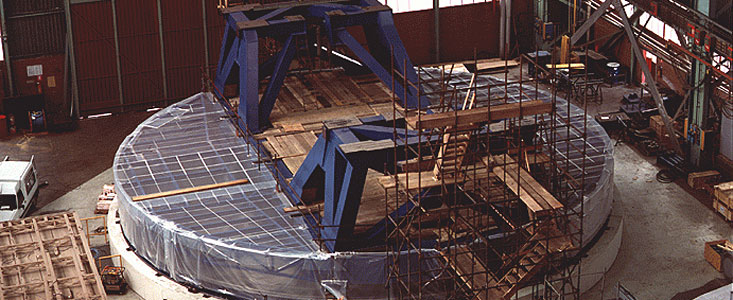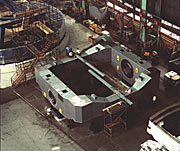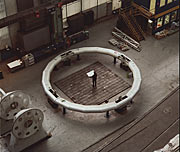Pressmeddelande
VLT 8.2-m Unit Telescope no. 1 (as on September 7, 1995)
13 september 1995
The construction of the ESO Very Large Telescope (VLT) advances rapidly, both in Europe and in Chile. These three photos show some of the main mechanical parts of the first 8.2-metre telescope, as they presented themselves in Milan (Italy) on Thursday, September 7, 1995. Two versions of these photos, one smaller and one larger and with better image resolution, are accessible for convenient transfer over the networks.
The mechanical structure of VLT Unit Telescope no. 1 is now in the process of being mounted at the Ansaldo Energia premises in Milan (Italy).
The so-called main structure (i.e., telescope azimuth and altitude mechanical structure, including hydrostatic bearing system, direct drives and direct mounted encoding system) was designed and is being built by the Italian consortium AES, composed of Ansaldo Energia (Genova), SOIMI (Milan) and EIE (Venice). Already two months from now, in November 1995, the complete, enormous mechanical structures of this telescope will be moving on the azimuth hydrostatic bearing tracks, using the direct drive system designed and built by the PHASE Company (Genova, Italy). The thorough testing phase will start by the end of December 1995 or at the beginning of January 1996.
ESO Press Photo eso9525a shows the lower part of the azimuth structure of the telescope (the fork) on the concrete pier on which the azimuth tracks (hydrostatic bearing journal) are mounted. The very high accuracy of this enormous structure (compare with the persons in the photo!) is illustrated by the fact that the "run-out" of the azimuth axis of the fork has been measured as only 80 microns (0.08 millimetres) on 90 degrees turning angle. This is a remarkable result, especially since the centering of the axis is done on a radial journal with a diameter of no less than 9 metres.
When the fork is equipped with all auxiliary systems, it will weigh about 320 t, will be 18 metres long and 8 metres wide. It will carry two Nasmyth platforms, each measuring 6 x 4 metres and situated 5.8 metres above the azimuth platform (here covered by plastic sheets).
ESO Press Photo eso9525b shows the centre piece of the telescope tube which provides the attachment points to the primary and secondary mirrors and has the shafts for the telescope altitude axis. It is 10.5 metres wide and 10 metres long and weighs about 56 t. To the shafts, here lying on the altitude hydrostatic bearing system, are attached the direct drives, which provide a maximum torque of 72 kNm. The associated encoder system is specified to deliver an absolute accuracy of 0.1 arcsec (rms).
The third view, ESO Press Photo eso9525c shows the top ring of the main strucure mounted and aligned, already painted in its definitive silver color (the interior part that faces the optical path will later be painted black to minimize internal optical reflections).
This top ring holds the secondary mirror unit. The inner diameter is 8.7 metres and it weighs 7.5 t. Following a careful study, it has been given a rounded shape in order to minimise the wind forces which are expected during the night at Paranal (an average of 10 to 15 m/s) without compromising the strict requirements for mechanical stiffness.
Om pressmeddelandet
| Pressmeddelande nr: | eso9525 |
| Legacy ID: | Photo 28-30/95 |
| Namn: | Paranal, Very Large Telescope, VLT Unit Telescopes |
| Typ: | Solar System : Star : Evolutionary Stage : Red Supergiant Unspecified : Technology : Observatory : Telescope |
| Facility: | Very Large Telescope |
Our use of Cookies
We use cookies that are essential for accessing our websites and using our services. We also use cookies to analyse, measure and improve our websites’ performance, to enable content sharing via social media and to display media content hosted on third-party platforms.
ESO Cookies Policy
The European Organisation for Astronomical Research in the Southern Hemisphere (ESO) is the pre-eminent intergovernmental science and technology organisation in astronomy. It carries out an ambitious programme focused on the design, construction and operation of powerful ground-based observing facilities for astronomy.
This Cookies Policy is intended to provide clarity by outlining the cookies used on the ESO public websites, their functions, the options you have for controlling them, and the ways you can contact us for additional details.
What are cookies?
Cookies are small pieces of data stored on your device by websites you visit. They serve various purposes, such as remembering login credentials and preferences and enhance your browsing experience.
Categories of cookies we use
Essential cookies (always active): These cookies are strictly necessary for the proper functioning of our website. Without these cookies, the website cannot operate correctly, and certain services, such as logging in or accessing secure areas, may not be available; because they are essential for the website’s operation, they cannot be disabled.
Functional Cookies: These cookies enhance your browsing experience by enabling additional features and personalization, such as remembering your preferences and settings. While not strictly necessary for the website to function, they improve usability and convenience; these cookies are only placed if you provide your consent.
Analytics cookies: These cookies collect information about how visitors interact with our website, such as which pages are visited most often and how users navigate the site. This data helps us improve website performance, optimize content, and enhance the user experience; these cookies are only placed if you provide your consent. We use the following analytics cookies.
Matomo Cookies:
This website uses Matomo (formerly Piwik), an open source software which enables the statistical analysis of website visits. Matomo uses cookies (text files) which are saved on your computer and which allow us to analyze how you use our website. The website user information generated by the cookies will only be saved on the servers of our IT Department. We use this information to analyze www.eso.org visits and to prepare reports on website activities. These data will not be disclosed to third parties.
On behalf of ESO, Matomo will use this information for the purpose of evaluating your use of the website, compiling reports on website activity and providing other services relating to website activity and internet usage.
Matomo cookies settings:
Additional Third-party cookies on ESO websites: some of our pages display content from external providers, e.g. YouTube.
Such third-party services are outside of ESO control and may, at any time, change their terms of service, use of cookies, etc.
YouTube: Some videos on the ESO website are embedded from ESO’s official YouTube channel. We have enabled YouTube’s privacy-enhanced mode, meaning that no cookies are set unless the user actively clicks on the video to play it. Additionally, in this mode, YouTube does not store any personally identifiable cookie data for embedded video playbacks. For more details, please refer to YouTube’s embedding videos information page.
Cookies can also be classified based on the following elements.
Regarding the domain, there are:
- First-party cookies, set by the website you are currently visiting. They are stored by the same domain that you are browsing and are used to enhance your experience on that site;
- Third-party cookies, set by a domain other than the one you are currently visiting.
As for their duration, cookies can be:
- Browser-session cookies, which are deleted when the user closes the browser;
- Stored cookies, which stay on the user's device for a predetermined period of time.
How to manage cookies
Cookie settings: You can modify your cookie choices for the ESO webpages at any time by clicking on the link Cookie settings at the bottom of any page.
In your browser: If you wish to delete cookies or instruct your browser to delete or block cookies by default, please visit the help pages of your browser:
Please be aware that if you delete or decline cookies, certain functionalities of our website may be not be available and your browsing experience may be affected.
You can set most browsers to prevent any cookies being placed on your device, but you may then have to manually adjust some preferences every time you visit a site/page. And some services and functionalities may not work properly at all (e.g. profile logging-in, shop check out).
Updates to the ESO Cookies Policy
The ESO Cookies Policy may be subject to future updates, which will be made available on this page.
Additional information
For any queries related to cookies, please contact: pdprATesoDOTorg.
As ESO public webpages are managed by our Department of Communication, your questions will be dealt with the support of the said Department.



